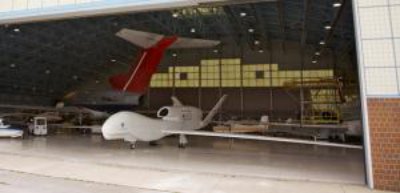The state of North Dakota is trying to position itself to become a leader in unmanned aircraft. Two years ago, the University of North Dakota became the first civilian school to offer a four-year degree in unmanned aircraft systems operations. Several other schools – in Alaska, Arizona, Florida – are now offering courses.
The new UAS training center in Grand Forks is located off-campus, at Grand Forks Air Force Base. The center includes a small room that’s essentially a cockpit on the ground. Pilots and sensor operators can watch what’s happening in the air through cameras on the plane. Students don’t fly real planes though; the FAA won’t allow that, so they have to content with simulated flights.
The undergraduate students studying unmanned aircraft systems begin their coursework by learning about aerodynamics as any traditional pilot would. Then the classes branch off to study the specifics of unmanned aircraft.
The students aren’t in the military, but they’ll likely end up working as military contractors when they graduate. That’s where the jobs are.
Associate Professor Ben Trapnell set up the UAS degree programme here. He used to be a Navy pilot, but he says that unmanned aircraft are the future.
“And if you do any research with the Army, the Air Force, there are people that will tell you they may have produced or are producing their last manned fighter.”
Trapnell sees a lot more than just military applications.
“I’ve got about 90 different uses for unmanned aircraft. But some of the big things: agricultural uses – we can get imagery to farmers a lot faster than having to wait for satellites to do the same thing – pipeline patrols, power line patrols, there’s the possibility of flying organs one place or another to get them there faster for transplants.”
At the moment, the FAA won’t allow unmanned planes to fly for civilian uses. Still, the state of North Dakota is positioning itself for when that day comes. It’s an ideal place to experiment with this new technology – wide open space and few people. Beyond the university programme, dozens of businesses are springing up to support the emerging industry. A nearby college – Northland Community and Technical College – is training students for unmanned aircraft repair.
Two unmanned aircraft are currently allowed to fly above North Dakota; they’re patrolling the Canadian border.
John Priddy directs the National Air Security Operations Center in Grand Forks for US Customs and Border Protection. He said unmanned planes offer certain advantages, namely they can stay airborne for 20 hours at a time.
“That reduces a lot of things for us: cost, time to get to different areas.”
Priddy said unmanned aircraft allow his team to quantify the threat level at different parts of a long border and identify where crossings are occurring.
The pilots here switch roughly every two hours. There’s also a team analyzing the data sent back.
“It’s the most challenging airplane I’ve ever flown,” said Priddy, who flew Apache helicopters for the Army. “You have to learn different cues for landing, and taking off that matter, but in particular landing, because you don’t have any aural perception, meaning you don’t hear the increase in the motor when you push the throttle forward, you don’t feel the acceleration.”
Source: PRI

